We may not have the course you’re looking for. If you enquire or give us a call on +45 89870423 and speak to our training experts, we may still be able to help with your training requirements.
Training Outcomes Within Your Budget!
We ensure quality, budget-alignment, and timely delivery by our expert instructors.
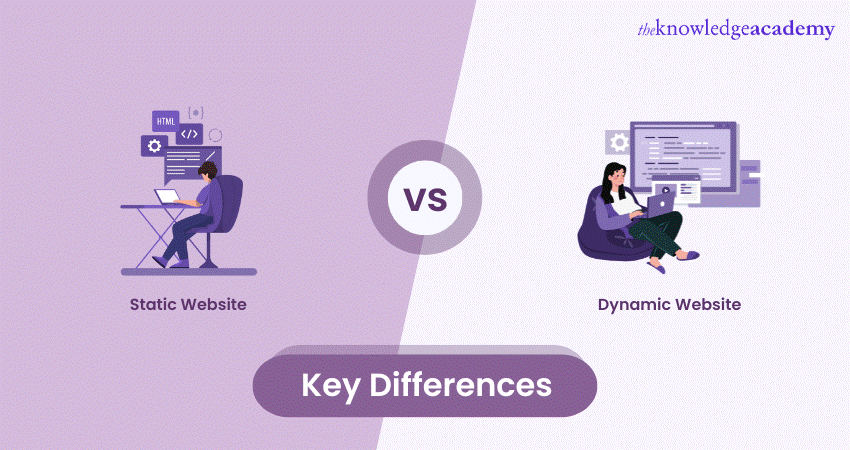
When it comes to Web Development, both Static and Dynamic Websites present distinct characteristics that shape users’ online experiences. Having a firm understanding of the key differences between both website types will help you unravel the complexities and make informed decisions in your quest to establish an effective online presence. A Static Website has fixed, unchanging content, while a Dynamic Website generates real-time content based on user interactions or other dynamic factors.
Table of Contents
1) What is a Static Website?
2) What is a Dynamic Website?
3) Difference between Static and Dynamic Website
a) Content of Web pages
b) Interaction with database
c) Loading Speed
d) Creation Costs
e) Programming Languages Used
f) Update process
g) Performance
4) Conclusion
What is a Static Website?
A static website is a traditional and straightforward type of web presence characterised by fixed content that remains constant for every user. Comprising primarily HTML and CSS files, a static website delivers pre-designed information to visitors without any dynamic or interactive elements.
Furthermore, the content on static pages remains the same unless manually updated, making it well-suited for projects with minimal requirements for frequent changes or user interactivity. The simplicity of Static Websites contributes to their efficiency and quick loading times, as there is no need for server-side processing or database queries.
More importantly, this makes Static Websites ideal for small businesses, personal portfolios, or landing pages where the focus is on presenting information without complex functionalities. Static Websites are often cost-effective to develop and host due to their straightforward architecture and lower server resource demands.
However, the trade-off for this simplicity is the limited interactivity and personalised experiences for users. Updates to content or design typically require manual intervention, making the maintenance process less agile compared to dynamic counterparts.
Moreover, while Static Websites may lack the dynamic features of their counterparts, they remain a viable choice for projects with static content and modest functionality requirements.
Advantages of a Static Website
Static Websites possess numerous advantages to their existence. Below are their detailed explanations. Have a look:

a) Easy to build: Static websites are notably easy to build, making them an ideal choice for projects with straightforward requirements. Since static websites consist mainly of HTML and CSS files, developers can quickly create and structure the content without the need for complex server-side scripting or database integration. The simplicity of the development process translates to faster turnaround times, making static websites a practical option for individuals and small businesses seeking a swift online presence.
b) Budget-friendly: One of the key advantages of static websites lies in their budget-friendly nature. The development and hosting costs for static sites are generally lower compared to dynamic counterparts. The straightforward architecture reduces the time and resources required for development, making it an economical choice for projects with limited budgets. This affordability factor is especially advantageous for startups, personal portfolios, or small businesses looking to establish an online presence without incurring significant expenses.
c) Faster performance: Static websites are renowned for their exceptional speed and performance. Since the content is fixed and doesn't require server-side processing, static pages load quickly for users. This swift performance contributes to an improved user experience, as visitors can access information without the delays associated with dynamic websites. Faster loading times not only enhance user satisfaction but also positively impact search engine rankings, as speed is a crucial factor in search algorithms.
d) Easier to cache: Caching is more straightforward with static websites, further enhancing their performance. Static pages are highly cacheable since the content remains constant for all users until manually updated. Caching involves storing copies of web pages or elements in a location closer to the user, reducing the need for repeated server requests. This results in faster load times and decreased server load. The simplicity of caching for static websites makes them an efficient choice for projects prioritising performance optimisation and a seamless user experience.
What is a Dynamic Website?
A Dynamic Website represents a modern and interactive approach to online presence, characterised by dynamic, ever-changing content tailored to individual users. Unlike Static Websites, dynamic counterparts leverage server-side scripting, databases, and Content Management Systems (CMS) to deliver personalised experiences and real-time updates.
Additionally, this type of website is particularly suitable for projects demanding frequent content changes, user interactions, and scalability. Dynamic Websites employ technologies such as PHP, ASP.NET, or Node.js, allowing server-side processing to generate content on the fly.
This enables features like user authentication, dynamic forms, and personalised recommendations, fostering a more engaging user experience. Content is often stored in databases, separating it from the presentation layer and facilitating seamless updates.
The advantages of Dynamic Websites include efficient content management, scalability for large-scale projects, and the ability to adapt to evolving user needs. Common use cases for dynamic websites include e-commerce platforms, social networks, and content-heavy sites where regular updates and interactivity are paramount.
However, Dynamic Websites may pose challenges in terms of development costs, server resources, and security considerations, requiring careful planning and maintenance to ensure optimal performance and security.
Advantages of a Dynamic Website
Using Dynamic Websites has numerous advantages. Below are their detailed explanations. Have a look:
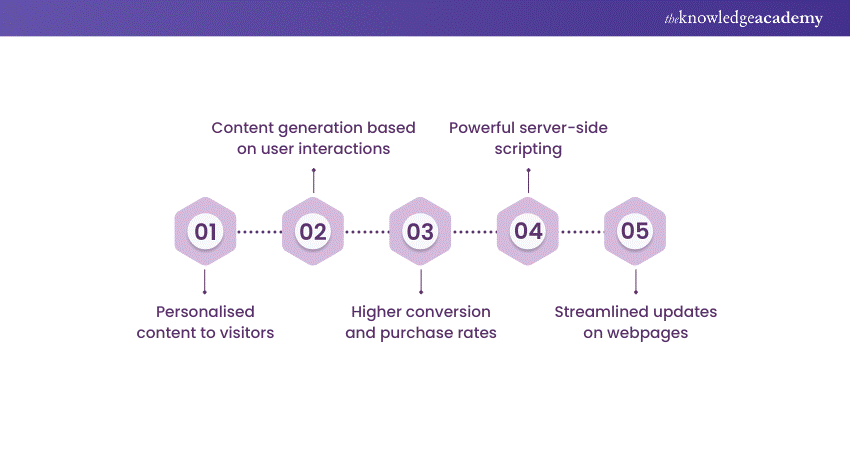
a) Personalised content for visitors: Dynamic websites excel in delivering personalised content tailored to individual visitors. Dynamic websites can dynamically generate content based on user interactions, preferences, and historical data by implementing server-side scripting and databases.
Moreover, personalisation enhances the user experience by presenting relevant information, product recommendations, and targeted marketing messages. This feature is precious for e-commerce platforms, news websites, and applications that aim to engage users with content suited to their interests. The ability to customise the user experience contributes to higher user satisfaction and increased retention rates.
b) Higher conversion and purchase rate: The dynamic nature of websites allows for sophisticated functionalities such as personalised shopping experiences, dynamic pricing, and targeted promotions, contributing to a higher conversion and purchase rate.
Moreover, e-commerce platforms leverage dynamic websites to implement features like shopping carts, user accounts, and secure payment gateways. With dynamic content, businesses can adapt their offerings based on user behaviour, showcase related products, and streamline the checkout process. These personalised and user-friendly features contribute to a more compelling online shopping experience, ultimately increasing the likelihood of conversions and purchases.
c) Powerful functionality due to server-side scripting: Dynamic Websites harness the power of server-side scripting languages like PHP, ASP.NET, and Node.js, enabling robust and complex functionalities. Server-side scripting allows real-time data processing, user authentication, and dynamic content generation.
Additionally, this capability is instrumental in creating interactive elements such as forms, user accounts, and CMS. The use of databases further enhances functionality by facilitating data storage, retrieval, and manipulation. More importantly, this powerful combination of server-side scripting and databases empowers dynamic websites to handle intricate tasks, making them suitable for applications that demand advanced features and dynamic user interactions.
d) Easier website updates: Dynamic Websites offer a streamlined process for updating content, thanks to Content Management Systems (CMS). CMS platforms allow non-technical users to easily add, edit, or remove content without delving into the intricacies of code.
Moreover, this ease of content management is especially advantageous for websites with frequently changing information, such as news portals or blogs. Content creators can update articles, images, and multimedia elements through a user-friendly interface, reducing the dependency on developers for routine content changes. The separation of content and presentation layers in Dynamic Websites facilitates efficient updates without compromising the overall design and functionality.
e) More scalability: Scalability is a critical factor for websites anticipating growth and increased traffic. Dynamic Websites, with their ability to handle large datasets and complex functionalities, offer superior scalability compared to static counterparts.
Additionally, as businesses expand and user demands evolve, dynamic websites can easily scale to accommodate increased traffic, additional features, and growing databases.
Moreover, this scalability is crucial for e-commerce platforms, social networks, and other dynamic sites experiencing variable levels of user engagement. The architecture of dynamic websites, with server-side processing and database capabilities, ensures that the site can grow seamlessly without compromising performance. This scalability feature positions dynamic websites as a reliable choice for projects with long-term growth objectives.
Difference between Static and Dynamic Website
Static Websites have fixed content and simple structures, ideal for basic information. They're easy to build, budget-friendly, and offer fast performance but lack interactivity. Dynamic Websites, powered by server-side scripting and databases, provide personalised content, advanced functionality, easier updates, and scalability.
They excel in user engagement, conversions, and handling complex projects. The differences between Static and Dynamic Websites are described in further detail below:
1) Content of web pages
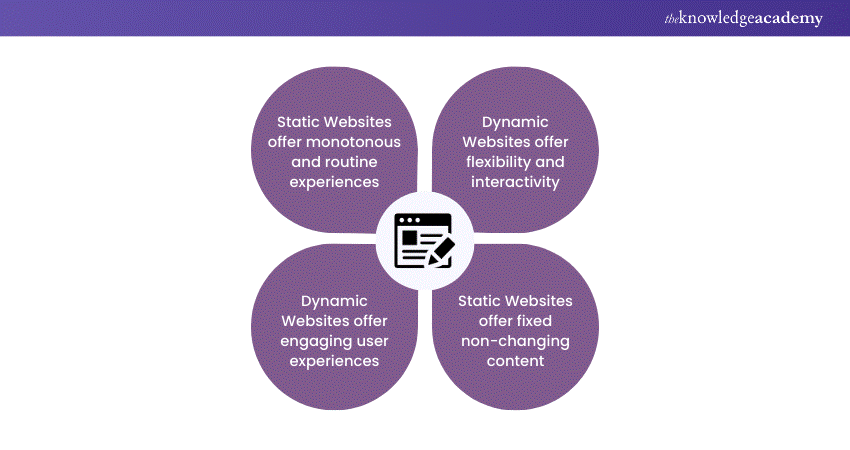
Static Websites feature fixed content that remains unchanged until manually updated. Content, typically HTML and CSS, is pre-rendered and served to all users consistently. In contrast, Dynamic Websites offer flexible, interactive content generated in real time using server-side scripting and databases.
These sites tailor content based on user interactions, preferences, and data. Dynamic pages can display personalised information, such as user accounts, recommendations, or real-time updates. The dynamic approach allows for a more engaging and customised user experience, making Dynamic Websites suitable for applications demanding frequent content changes, user interactions, and personalised content delivery. The choice between static and dynamic content depends on the project's needs, scalability requirements, and the level of interactivity desired.
2) Interaction with database
Static websites typically lack direct database interaction, consisting of fixed content served directly to users. Any changes to content involve manual updates to the HTML and CSS files. In contrast, dynamic websites leverage databases extensively.
Additionally, server-side scripting enables dynamic content generation by interacting with databases to retrieve, update, and manipulate information in real time. User authentication, personalised content delivery, and dynamic functionalities like shopping carts or user accounts are made possible through this database interaction.
Moreover, Dynamic websites store and retrieve data efficiently, providing a more interactive and adaptive user experience. The database-driven approach of dynamic websites is essential for handling large datasets, facilitating content management, and ensuring scalability for projects with evolving content and user needs.
3) Loading speed
Static websites are renowned for faster loading speeds, delivering fixed content directly to users without server-side processing. Static pages load swiftly with minimal dependencies and straightforward structures, ensuring a seamless and efficient user experience.
On the other hand, dynamic websites involving server-side scripting and database interactions may experience slightly slower loading times. The need for real-time content generation and data retrieval can introduce latency. However, advancements in caching strategies and optimisation techniques have significantly improved dynamic website loading speeds.
While dynamic websites may not match the instantaneous loading of static counterparts, modern practices mitigate the difference, allowing dynamic sites to deliver content efficiently and responsively, especially when leveraging caching mechanisms and optimising server performance.
4) Creation costs
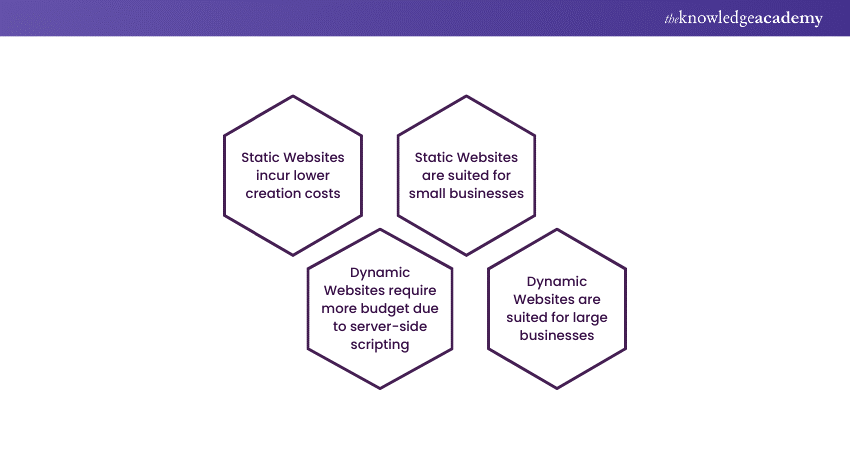
Static websites generally incur lower creation costs due to their simplicity. Building static sites involves minimal development effort, primarily relying on HTML and CSS coding, resulting in cost-effective solutions suitable for small businesses, personal portfolios, or basic online presence. Additionally, the absence of complex server-side scripting and databases reduces development time and resource requirements, contributing to overall affordability.
Dynamic websites, in contrast, often involve higher creation costs. Implementing server-side scripting, databases, and dynamic functionalities demands more advanced development skills and additional time. The complexity increases development expenses, making dynamic websites more suitable for projects with extensive features, interactivity, and scalability needs.
Despite the higher initial costs, dynamic websites can offer substantial long-term value for businesses seeking advanced functionalities, personalised user experiences, and the ability to adapt to evolving requirements.
5) Programming languages used
Static websites primarily employ simpler programming languages such as HTML, CSS, and occasionally JavaScript for basic interactivity. These languages focus on defining the structure, style, and minimal client-side functionalities.
Dynamic websites leverage more diverse programming languages, including server-side scripting languages like PHP, ASP.NET, or Node.js. These languages facilitate real-time processing, database interactions, and complex functionalities.
Additionally, dynamic websites often utilise JavaScript for enhanced client-side interactivity. The dynamic approach allows for a broader range of programming languages to be integrated, offering flexibility and power for projects with advanced requirements.
6) Update process
Static websites face challenges in the update process as changes require manual modification of HTML and CSS files, potentially demanding coding skills. Conversely, dynamic websites offer a more user-friendly update process, thanks to CMS.
With a CMS, non-technical users can easily update content through an intuitive interface, separating content from code. This ease of updating is advantageous for dynamic websites, particularly those with frequently changing information, as it streamlines the maintenance process and reduces dependency on developers for routine content changes.
7) Performance
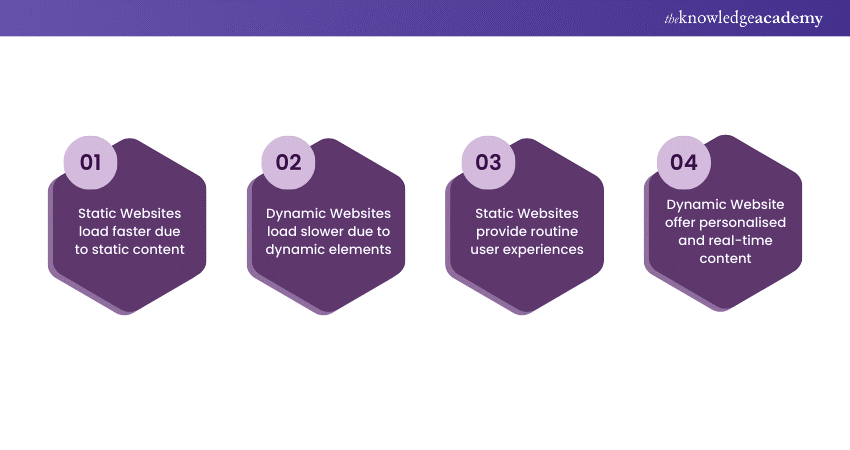
Static websites boast faster performance, loading quickly as they deliver fixed content directly to users without server-side processing. Their simplicity and lack of dynamic elements contribute to efficient page rendering. Dynamic websites, while slightly slower due to server-side scripting and database interactions, have enhanced capabilities.
Real-time content generation, personalised user experiences, and complex functionalities define their performance. Advances in caching strategies and optimisation techniques have significantly improved dynamic website loading speeds, making them competitive with static counterparts, especially for projects leveraging modern practices to ensure responsive and efficient content delivery.
Master the art of creating engaging and user-friendly websites by signing up for our Website Design Course now!
Conclusion
In conclusion, choosing between a Static vs Dynamic Website hinges on project needs. Static sites are simple and cost-effective, while dynamic counterparts offer personalised experiences and advanced functionalities. Understanding these distinctions ensures informed decision-making and aligns your website with specific goals and user expectations.
Frequently Asked Questions

A Dynamic Website gains a competitive edge over a Static Website when it comes to functionality. Dynamic web pages are designed to possess boundless functionality which is restrained by logic and the language necessary to build them.
On the other hand, a Static Website already has existing web pages which search engine crawlers can view the same way as users do. Whereas a Dynamic Website needs to include a few static elements on the page if the user wants it to rank in the search engine result pages.

A Static Website loads faster which makes search engines rank it higher, and it also does not require complex software to be developed. Additionally, it is budget-friendly to build, and users can easily change the layout and design of every web page. Moreover, a user can view the Static Website the exact same manner in which it is stored and also navigate at great speed across the website in a streamlined manner. A Static website is typically utilised for web pages wherein the information does not need regular updates, and best suited to small-sized websites because the maintenance of a Static Website is complicated.

You can determine if a website is Static or Dynamic depending on whether you can interact with it. For example, a Static Website does not allow users to create their profiles, make comments on a post or other interactive actions. A Dynamic website also displays content based on user preferences or activity, such as social media websites. Moreover, if a website loads instantly within milliseconds, it is a Static Website, otherwise it is Dynamic.

The Knowledge Academy takes global learning to new heights, offering over 30,000 online courses across 490+ locations in 220 countries. This expansive reach ensures accessibility and convenience for learners worldwide.
Alongside our diverse Online Course Catalogue, encompassing 17 major categories, we go the extra mile by providing a plethora of free educational Online Resources like News updates, blogs, videos, webinars, and interview questions. Tailoring learning experiences further, professionals can maximise value with customisable Course Bundles of TKA.

The Knowledge Academy offers various App & Web Development Training courses, including Website Design, UX/UI Design Jumpstart, Introduction to HTML and WordPress Essentials. These courses cater to different skill levels, providing comprehensive insights into App & Web Development methodologies.
Our App & Web Development Training blogs cover a range of topics related to Web Design, offering valuable resources, best practices, and industry insights. Whether you are a beginner or looking to advance your App & Web Development skills, The Knowledge Academy's diverse courses and informative blogs have you covered.
Upcoming Programming & DevOps Resources Batches & Dates
Date
 Website Design Course
Website Design Course
Thu 30th Jan 2025
Thu 27th Mar 2025
Thu 29th May 2025
Thu 24th Jul 2025
Thu 25th Sep 2025
Thu 27th Nov 2025







 Top Rated Course
Top Rated Course



 If you wish to make any changes to your course, please
If you wish to make any changes to your course, please


